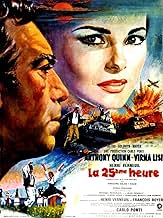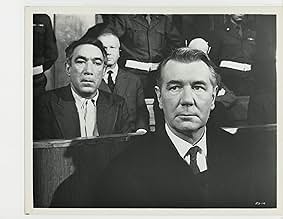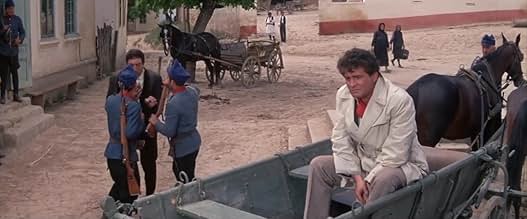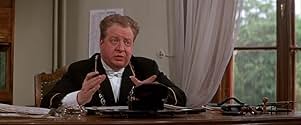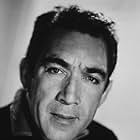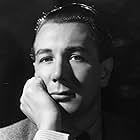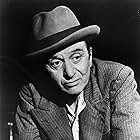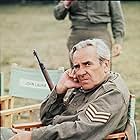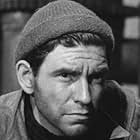IMDb RATING
7.4/10
2.4K
YOUR RATING
In World War II, a Romanian gentile peasant is denounced by the village gendarme and sent to a concentration camp for Jews where, due to an error, he's drafted into the S.S.In World War II, a Romanian gentile peasant is denounced by the village gendarme and sent to a concentration camp for Jews where, due to an error, he's drafted into the S.S.In World War II, a Romanian gentile peasant is denounced by the village gendarme and sent to a concentration camp for Jews where, due to an error, he's drafted into the S.S.
Marcel Dalio
- Strul
- (as Dalio)
Robert Beatty
- Col. Greenfield
- (uncredited)
Stojan Decermic
- Marcou
- (uncredited)
Raoul Delfosse
- The Bailiff
- (uncredited)
Jean Desailly
- Cabinet Minister
- (uncredited)
Storyline
Did you know
- TriviaThe original European print release ran three hours and sixteen minutes. The American release and subsequent DVD runs two hours and ten minutes.
- GoofsQuinn's character is taken prisoner by the U.S. 24th Infantry Division in 1945. This couldn't have happened as the 24th was fighting in the Philippines at that time and would later be sent to Japan on occupation duties.
- Quotes
Johann Moritz: I keep forgetting, I'm not a prisoner.
- ConnectionsEdited into Voskovec & Werich - paralelní osudy (2012)
Featured review
I caught up with this movie on TV after 30 years or more. Several aspects of the film stood out even when viewing it so many years after it was made.
The story by the little known C Virgil Georghiu is remarkable, almost resembling a Tolstoy-like story of a man buffeted by a cosmic scheme that he cannot comprehend. Compare this film with better-known contemporary works such as Spelberg's "Schindler's List" and you begin to realize the trauma of the World War II should be seen against the larger canvas of racism beyond the simplistic Nazi notion of Aryan vs Jews. This film touches on the Hungarians dislike for the Romanians, the Romanians dislike of the Russians and so on..even touching on the Jews' questionable relationships with their Christian Romanian friends, while under stress.
As I have not read the book, it is difficult to see how much has been changed by the director and screenplay writers. For instance, it is interesting to study the Romanian peasant's view of emigrating to USA with the view of making money only to return to Romania and invest his earnings there.
In my opinion, the character of Johann Moritz was probably one of the finest roles played by Anthony Quinn ranking alongside his work in "La Strada","Zorba the Greek" and "Barabbas".
The finest and most memorable sequence in the film is the final one with Anthony Quinn and Virna Lisi trying to smile. The father carrying a daughter born out his wife's rape by Russians is a story in itself but the director is able to show the reconciliation by a simple gesture--the act of carrying the child without slipping into melodramatic footage.
Today after the death of Princess Diana we often remark about the insensitive paparazzi. The final sequence is an indictment of the paparazzi and the insensitive media (director Verneuil also makes a similar comment during the court scene as the cameramen get ready to pounce on Moritz).
The interaction between Church and State was so beautifully summed up in the orthodox priest's laconic statement "I pray to God that He guides those who have power to use them well."
Some of the brief shots, such as those of a secretary of a minister doodling while listening to a petition--said so much in so little footage. The direction was so impressive that the editing takes a back seat.
Finally what struck me most was the exquisite rich texture of colors provided by the cameraman Andreas Winding--from the brilliant credit sequences to the end. I recalled that he was the cameraman of another favorite French film of mine called "Ramparts of Clay" directed by Jean-Louis Bertucelli. I have not seen such use of colors in a long while save for the David Lean epics.
There were flaws: I wish Virna Lisi's character was more fleshed out. I could never quite understand the Serge Reggiani character--the only intellectual in the entire film. The railroad station scene at the end seems to be lifted out of Sergio Leone westerns. Finally, the film was essentially built around a love story, that unfortunately takes a back seat.
To sum up this film impressed me in more departments than one. The story is relevant today as it was when it was made.
The story by the little known C Virgil Georghiu is remarkable, almost resembling a Tolstoy-like story of a man buffeted by a cosmic scheme that he cannot comprehend. Compare this film with better-known contemporary works such as Spelberg's "Schindler's List" and you begin to realize the trauma of the World War II should be seen against the larger canvas of racism beyond the simplistic Nazi notion of Aryan vs Jews. This film touches on the Hungarians dislike for the Romanians, the Romanians dislike of the Russians and so on..even touching on the Jews' questionable relationships with their Christian Romanian friends, while under stress.
As I have not read the book, it is difficult to see how much has been changed by the director and screenplay writers. For instance, it is interesting to study the Romanian peasant's view of emigrating to USA with the view of making money only to return to Romania and invest his earnings there.
In my opinion, the character of Johann Moritz was probably one of the finest roles played by Anthony Quinn ranking alongside his work in "La Strada","Zorba the Greek" and "Barabbas".
The finest and most memorable sequence in the film is the final one with Anthony Quinn and Virna Lisi trying to smile. The father carrying a daughter born out his wife's rape by Russians is a story in itself but the director is able to show the reconciliation by a simple gesture--the act of carrying the child without slipping into melodramatic footage.
Today after the death of Princess Diana we often remark about the insensitive paparazzi. The final sequence is an indictment of the paparazzi and the insensitive media (director Verneuil also makes a similar comment during the court scene as the cameramen get ready to pounce on Moritz).
The interaction between Church and State was so beautifully summed up in the orthodox priest's laconic statement "I pray to God that He guides those who have power to use them well."
Some of the brief shots, such as those of a secretary of a minister doodling while listening to a petition--said so much in so little footage. The direction was so impressive that the editing takes a back seat.
Finally what struck me most was the exquisite rich texture of colors provided by the cameraman Andreas Winding--from the brilliant credit sequences to the end. I recalled that he was the cameraman of another favorite French film of mine called "Ramparts of Clay" directed by Jean-Louis Bertucelli. I have not seen such use of colors in a long while save for the David Lean epics.
There were flaws: I wish Virna Lisi's character was more fleshed out. I could never quite understand the Serge Reggiani character--the only intellectual in the entire film. The railroad station scene at the end seems to be lifted out of Sergio Leone westerns. Finally, the film was essentially built around a love story, that unfortunately takes a back seat.
To sum up this film impressed me in more departments than one. The story is relevant today as it was when it was made.
- JuguAbraham
- Jan 10, 2002
- Permalink
- How long is The 25th Hour?Powered by Alexa
Details
- Runtime2 hours 10 minutes
- Aspect ratio
- 2.35 : 1
Contribute to this page
Suggest an edit or add missing content


